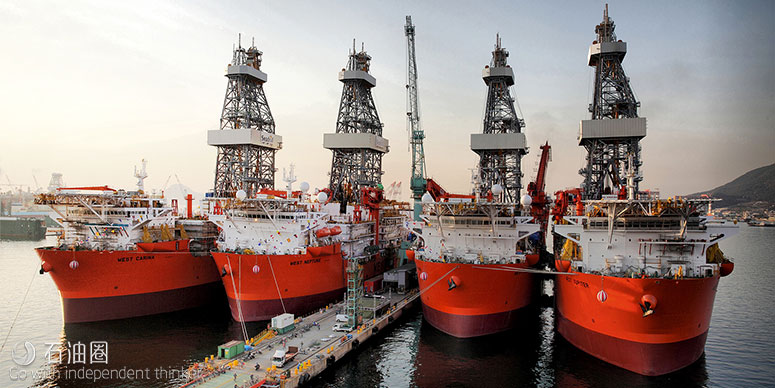“Highway”For Downhole Data Delivers Optimized Drilling
Wired drillpipe (WDP) technology has been used since 2006 and in more than 175 wells worldwide. By creating a high-speed telemetry network, WDP has become a reliable and competitive technology that enables operators to drill more efficiently and save time. Since 2014 WDP has been used on the Maersk Intrepid jackup.
A field being developed in the Norwegian North Sea presented several challenges: hole stability with unstable shales and unconsolidated sands, a narrow mud weight window (necessitating strong focus on equivalent circulating density management and hole cleaning) and a narrow true vertical depth window for placing reservoir drains.
WDP technology was implemented to address these difficulties and to optimize telemetry and hole cleaning practices. National Oilwell Varco (NOV) provided along-string measurement (ASM) tools for an improved understanding of the environment along the entire hole. These real-time data allowed better control of operations, which resulted in additional reservoir drilling of 1,000 m (3,281 ft) and saved one well.
WDP also enabled drilling optimization by way of automation. Its customized performance applications installed within the Cyberbase drilling control system allowed handling of surface parameters while the driller supervised and confirmed actions at given steps.
Standard drillstring components were converted for use in the IntelliServ high-speed telemetry network. Inductive coils placed in the secondary shoulders of the box and pin were connected by an armored coaxial cable through which the data traveled. Mechanical properties of the pipe were unchanged and remained suitable for cementing and other through-string operations. WDP provided the “highway” that enabled instantaneous transmission of downhole data.
WDP overview
Figure 1 shows an overview of the IntelliServ network, including the BlackStream ASM and enhanced measurement system (EMS) tools. These collar-based tools were placed along the string that acquires and transmits high-speed measurements independently of mud flow.
Several adjustments were required within the rig surface system to become WDP-ready. First, NOV personnel performed modifications on the top drive with the following components:
1.the DataSwivel that connected the wired drilling tools to the surface cabling;
2.modified internal BOP actuator components;
3.wired internal BOPs;
4.wired saver subs.
NOV installed surface cabling along the top drive service loop to transmit data from the DataSwivel to the network control system (NetCon). The NetCon receives downhole data and transfers the data to third-party vendors.
The Maersk drill crew was familiarized with the handling of the WDP. HydraTong settings were fine-tuned for making up TT550 connections, with clamping pressure reduced and jaw placement below the connections established. A stabbing guide was added to the iron roughneck to ensure correct alignment. To reduce the lead time for wired components, generic safety stock was established and a repair facility was set up in Norway.
The BlackStream ASM and EMS tools provide realtime measurements from along the wired string. Data are streamed even with flow-off, providing insight into equivalent static density distribution at connections or during critical events such as losses. Benefits include better hole-cleaning monitoring, enhancements to the managed-pressure drilling process, control of downhole torque while setting liner hanger, etc.
To make the most of the large amount of data transmitted, the Cyberbase system was slightly modified to include an interface with automation applications and visualizations. These smart applications were designed to calculate optimized set points for the machines such as the top drive and drawworks, which control the drilling process.
An enhanced display was placed to improve visualization of ASM data. The equivalent fluid density viewer plots lateral vibrations and equivalent circulating density/ equivalent static density against time and depth according to a color scale.
The SoftSpeed II system has been in place since the start of the campaign. This system uses automated vibration dampening to reduce stick/slip oscillations. SoftSpeed II software allows control of the top drive rpm in a way that mitigates torsional vibration along the drillstring.
The TrueDrill application was installed to display downhole weight on bit (WOB). The system uses highspeed downhole measurements from BlackStream EMS tools and makes it possible to adjust surface WOB to maintain downhole WOB. On the Maersk Intrepid the driller could visualize downhole WOB against surface WOB and could compare it to the autodriller set point all on one screen.
The DrillShark optimization service was implemented to reach the best mechanical-specific energy. This system uses surface data and search algorithms for automated adjustments to the WOB and rpm set points.
The changes to the Cyberbase system were commissioned after installation to ensure seamless integration, and it was confirmed that the safe operation limits selected by the driller were respected.
The Maersk drill crew was trained at the rig site to safely operate the upgraded Cyberbase system. A handson approach helped to quickly familiarize the crew with the functions and visualizations of the automation system, which was implemented in stages to develop trust and build knowledge.
In the first stage applications provide visualization only, allowing the user to become familiar with the new features. In the second stage the applications recommend set points that are only implemented when accepted by the driller. Applications automatically adjust set points within preset limits in the third stage. The third stage has not yet been implemented for the Maersk Intrepid.
It also should be noted that the automation initiative brought a stronger focus on optimization and parameters management from all parties on board. With the introduction of this new system, all personnel worked as a team to achieve better results.
Results
With the successful development of this challenging field, the WDP and ASM tools proved of primary importance to conduct safe and efficient operations.
These improvements amounted to an increased reservoir section length of about 1,000 m, which meant that one less well was required to reach planned production levels. This saved the equivalent of 70 days rig time. Going forward it is expected that WDP technology will be of utmost importance for closed-loop automation, where high-speed drilling data from the downhole system is fed into rig controls.

 石油圈
石油圈
